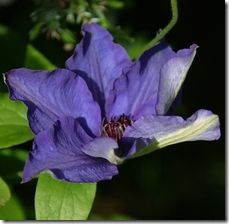Clemson brightens up the summer garden with its spectacular flowering vines. With blooms in a rainbow of colors, including blue, pink, red, purple and white, the clematis is an easy-to-grow perennial. Most varieties are woody and deciduous, though one is evergreen and a few are herbaceous perennials, according to Clemson Extension. Clematis wilt, which can suddenly hit a healthy plant, is a common problem for some varieties, but it is fairly easy to treat.
Magnesium Deficiency
-
Symptoms of magnesium deficiency start in the oldest leaves of a clematis. The leaves, which are not producing enough chlorophyll, will yellow, then wilt and drop. Spray a mixture of 1/4 cup Epsom salts (magnesium sulphate) and 1 gallon of water onto your clematis’ leaves. It may take several applications before the plant looks better. You may also sprinkle 1/4 to 1/2 cup of Epsom salts around the plant, then water well.
Clematis Wilt
-
The cause of clematis wilt is not definitively known, but it may be the fungus Ascochyta clematidina. Plants are more susceptible during damp weather, and damage is more frequent in early summer. According to master gardener Carol Figarra, large-flowered, spring-blooming clematis varieties are most susceptible to clematis wilt. Initial symptoms make it appear that a healthy clematis is suddenly in need of for water. The plant will droop and shrivel, with growing tips becoming very limp, then eventually collapse. However, clematis wilt is rarely fatal to the whole plant; the fungus generally attacks only a few shoots.
Treatment
-
Infected stems should be removed, cutting as close to the root as possible. Do not compost the stems; throw them in the trash or bury them. As a preventive measure, Figarra recommends using a systemic fungicide, soaking the plant’s roots at planting time, each spring and as soon as wilt symptoms are spotted. You also may help keep your plant healthy and green by ensuring it receives enough magnesium.
Varieties
-
To greatly reduce the chance of your plants developing clematis wilt, choose varieties known to be free of fungal problems. Washington State University Extension recommends Clematis Montana, Clematis macropetala, Clematis alpina and Clematis viticella, as well as some of their cultivars.


Deprecated: strpos(): Passing null to parameter #1 ($haystack) of type string is deprecated in /home/agriviek8Qv/agriviet.net/public_html/wp-includes/comment-template.php on line 2522